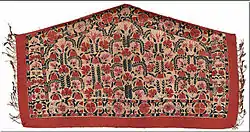
Yomut asmalyk, pile carpet, first half of 19th century

Tekke asmalyk, embroidered silk, mid-19th century
An asmalyk (Turkmen language, "a thing to be hung"[1]) is a textile trapping used in a Turkmen wedding procession. Asmalyks may be pile or embroidered, and are usually five-sided, but some are seven-sided. Yomut asmalyks are the most common, followed by those of the Tekke tribe.[2] Asmalyks were made in pairs to decorate the flanks of a bride's wedding camel, and were then hung in her domed, felt-covered tent.[3]
References
- ↑ "Turkmen Rugs: A Guide To Turkmen Rug & Carpet Styles". www.spongobongo.com. Retrieved 2018-09-15.
- ↑ "Yomut Asmalyk". www.spongobongo.com. Retrieved 2018-09-15.
- ↑ "Collector's Eye No. 45". www.ne-rugsociety.org. Retrieved 2018-09-15.
External links
This article is issued from Wikipedia. The text is licensed under Creative Commons - Attribution - Sharealike. Additional terms may apply for the media files.